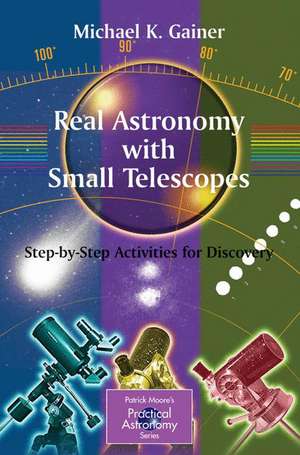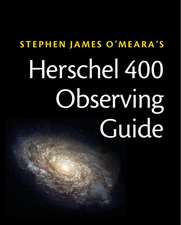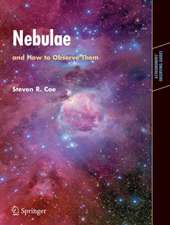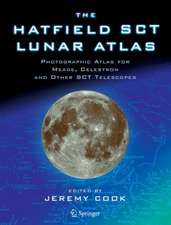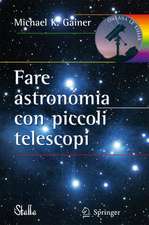Real Astronomy with Small Telescopes: Step-by-Step Activities for Discovery: The Patrick Moore Practical Astronomy Series
Autor Michael Gaineren Limba Engleză Paperback – 12 dec 2006
Din seria The Patrick Moore Practical Astronomy Series
-
 Preț: 258.21 lei
Preț: 258.21 lei -
 Preț: 164.94 lei
Preț: 164.94 lei -
 Preț: 324.21 lei
Preț: 324.21 lei -
 Preț: 255.10 lei
Preț: 255.10 lei - 8%
 Preț: 581.98 lei
Preț: 581.98 lei -
 Preț: 159.16 lei
Preț: 159.16 lei -
 Preț: 282.38 lei
Preț: 282.38 lei -
 Preț: 308.55 lei
Preț: 308.55 lei -
 Preț: 309.87 lei
Preț: 309.87 lei -
 Preț: 332.98 lei
Preț: 332.98 lei -
 Preț: 276.91 lei
Preț: 276.91 lei -
 Preț: 243.94 lei
Preț: 243.94 lei -
 Preț: 183.40 lei
Preț: 183.40 lei -
 Preț: 378.09 lei
Preț: 378.09 lei -
 Preț: 302.20 lei
Preț: 302.20 lei -
 Preț: 210.01 lei
Preț: 210.01 lei -
 Preț: 212.68 lei
Preț: 212.68 lei -
 Preț: 271.39 lei
Preț: 271.39 lei -
 Preț: 252.91 lei
Preț: 252.91 lei -
 Preț: 281.95 lei
Preț: 281.95 lei -
 Preț: 289.85 lei
Preț: 289.85 lei -
 Preț: 218.84 lei
Preț: 218.84 lei -
 Preț: 282.38 lei
Preț: 282.38 lei -
 Preț: 128.86 lei
Preț: 128.86 lei -
 Preț: 301.10 lei
Preț: 301.10 lei -
 Preț: 204.78 lei
Preț: 204.78 lei -
 Preț: 307.44 lei
Preț: 307.44 lei -
 Preț: 303.07 lei
Preț: 303.07 lei -
 Preț: 258.83 lei
Preț: 258.83 lei -
 Preț: 193.97 lei
Preț: 193.97 lei -
 Preț: 208.26 lei
Preț: 208.26 lei -
 Preț: 279.09 lei
Preț: 279.09 lei -
 Preț: 303.51 lei
Preț: 303.51 lei -
 Preț: 277.54 lei
Preț: 277.54 lei -
 Preț: 208.51 lei
Preț: 208.51 lei -
 Preț: 214.86 lei
Preț: 214.86 lei -
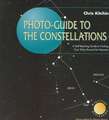 Preț: 304.58 lei
Preț: 304.58 lei -
 Preț: 220.57 lei
Preț: 220.57 lei -
 Preț: 157.32 lei
Preț: 157.32 lei -
 Preț: 275.98 lei
Preț: 275.98 lei -
 Preț: 288.98 lei
Preț: 288.98 lei -
 Preț: 261.49 lei
Preț: 261.49 lei -
 Preț: 279.09 lei
Preț: 279.09 lei -
 Preț: 160.82 lei
Preț: 160.82 lei -
 Preț: 327.01 lei
Preț: 327.01 lei -
 Preț: 254.90 lei
Preț: 254.90 lei -
 Preț: 304.38 lei
Preț: 304.38 lei -
 Preț: 256.84 lei
Preț: 256.84 lei
Preț: 155.25 lei
Nou
Puncte Express: 233
Preț estimativ în valută:
29.71€ • 31.02$ • 24.59£
29.71€ • 31.02$ • 24.59£
Carte disponibilă
Livrare economică 14-28 martie
Preluare comenzi: 021 569.72.76
Specificații
ISBN-13: 9781846284786
ISBN-10: 1846284783
Pagini: 168
Ilustrații: XVI, 148 p. 90 illus.
Dimensiuni: 155 x 235 x 12 mm
Greutate: 0.29 kg
Ediția:2007
Editura: SPRINGER LONDON
Colecția Springer
Seria The Patrick Moore Practical Astronomy Series
Locul publicării:London, United Kingdom
ISBN-10: 1846284783
Pagini: 168
Ilustrații: XVI, 148 p. 90 illus.
Dimensiuni: 155 x 235 x 12 mm
Greutate: 0.29 kg
Ediția:2007
Editura: SPRINGER LONDON
Colecția Springer
Seria The Patrick Moore Practical Astronomy Series
Locul publicării:London, United Kingdom
Public țintă
Popular/generalCuprins
The Celestial Sphere.- The Measurement of Time.- The Equatorial Telescope Mount.- Telescope Considerations.- Astronomical Photography.- The Sun.- The Moon.- The Planets.- Comets and Asteroids.- Visual Binary Stars.- A Binary Star True Orbit Projector.- Visual Observations of Variable Stars.- Photography of Variable Stars.- Star Clusters and Nebulae.- A Color–Magnitude Diagram for The Pleiades.- The Design of an Objective Prism Spectrograph.- The Proper Motion of Barnard’s Star.
Recenzii
From the reviews:
"The dozens of projects collected here are a combination of observations suitable for current research (such as classifying sun-spots or monitoring binary stars) and recreating classic experiments (such as determining the speed of light by timing Jupiter’s moons). … Besides ample nuggets for science projects, a motivated amateur will gain understanding by doing the work, and … add purpose to his or her observations." (Stuart J. Goldman, Sky & Telescope, May, 2007)
"Amateurs and students using relatively small telescopes can and do contribute useful data to many areas of astronomy. The subtitle Step-by-Step Activities for Discovery is an accurate depiction of what is provided to help novices do just that. Charts, diagrams, photographs of setups, and background information for a variety of observations are included. … Summing Up: Recommended. General reader; lower-division undergraduates; faculty." (D. H. Gifford, CHOICE, Vol. 44 (11), August, 2007)
"The dozens of projects collected here are a combination of observations suitable for current research (such as classifying sun-spots or monitoring binary stars) and recreating classic experiments (such as determining the speed of light by timing Jupiter’s moons). … Besides ample nuggets for science projects, a motivated amateur will gain understanding by doing the work, and … add purpose to his or her observations." (Stuart J. Goldman, Sky & Telescope, May, 2007)
"Amateurs and students using relatively small telescopes can and do contribute useful data to many areas of astronomy. The subtitle Step-by-Step Activities for Discovery is an accurate depiction of what is provided to help novices do just that. Charts, diagrams, photographs of setups, and background information for a variety of observations are included. … Summing Up: Recommended. General reader; lower-division undergraduates; faculty." (D. H. Gifford, CHOICE, Vol. 44 (11), August, 2007)
Textul de pe ultima copertă
It’s often said that astronomy is one of the very few sciences in which amateurs can make a contribution to real science. Even modest telescopes such as a small – 3-inch (80mm) – astronomical refractor or Maksutov can provide scientifically useful data.
This is certainly true, but where to start?
Real Astronomy with Small Telescopes tells you everything you’ll need to know about how to get started on "real" astronomy using a small telescope (and ideally a digital camera), and make a real contribution to our scientific knowledge. This book is the necessary introduction to real astronomy – derived from the author’s many years of experience in teaching the subject – that can be your starting point for serious work. Here, the emphasis is on what you can do with a small telescope, rather than just on what you can see through it.
Finally, owners of big telescopes shouldn’t be put off – everything in this book applies equally (maybe more equally!) to larger instruments.
This is certainly true, but where to start?
Real Astronomy with Small Telescopes tells you everything you’ll need to know about how to get started on "real" astronomy using a small telescope (and ideally a digital camera), and make a real contribution to our scientific knowledge. This book is the necessary introduction to real astronomy – derived from the author’s many years of experience in teaching the subject – that can be your starting point for serious work. Here, the emphasis is on what you can do with a small telescope, rather than just on what you can see through it.
Finally, owners of big telescopes shouldn’t be put off – everything in this book applies equally (maybe more equally!) to larger instruments.
Caracteristici
Effectively demonstrates the use of an 80mm refractor for more than a "quick look" – it can be used as a real scientific instrument Demonstrates the significant observations that can be made with a small telescope Provides clear step-by-step instructions for numerous scientific activities Includes chapters on digital photography of the Sun and Moon The author is an experienced small telescope user, as well as an astronomy educator Includes supplementary material: sn.pub/extras
